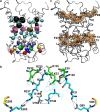Single-nucleotide evolution quantifies the importance of each site along the structure of mitochondrial carriers
- PMID: 23800987
- PMCID: PMC11113836
- DOI: 10.1007/s00018-013-1389-y
Single-nucleotide evolution quantifies the importance of each site along the structure of mitochondrial carriers
Abstract
Mitochondrial carriers are membrane-embedded proteins consisting of a tripartite structure, a three-fold pseudo-symmetry, related sequences, and similar folding whose main function is to catalyze the transport of various metabolites, nucleotides, and coenzymes across the inner mitochondrial membrane. In this study, the evolutionary rate in vertebrates was screened at each of the approximately 50,000 nucleotides corresponding to the amino acids of the 53 human mitochondrial carriers. Using this information as a starting point, a scoring system was developed to quantify the evolutionary pressure acting on each site of the common mitochondrial carrier structure and estimate its functional or structural relevance. The degree of evolutionary selection varied greatly among all sites, but it was highly similar among the three symmetric positions in the tripartite structure, known as symmetry-related sites or triplets, suggesting that each triplet constitutes an evolutionary unit. Based on evolutionary selection, 111 structural sites (37 triplets) were found to be important. These sites play a key role in structure/function of mitochondrial carriers and are involved in either conformational changes (sites of the gates, proline-glycine levels, and aromatic belts) or in binding and specificity of the transported substrates (sites of the substrate-binding area in between the two gates). Furthermore, the evolutionary pressure analysis revealed that the matrix short helix sites underwent different degrees of selection with high inter-paralog variability. Evidence is presented that these sites form a new sequence motif in a subset of mitochondrial carriers, including the ADP/ATP translocator, and play a regulatory function by interacting with ligands and/or proteins of the mitochondrial matrix.
Conflict of interest statement
The authors have no conflicts of interest to declare.
Figures






References
Publication types
MeSH terms
Substances
LinkOut - more resources
Full Text Sources
Other Literature Sources

